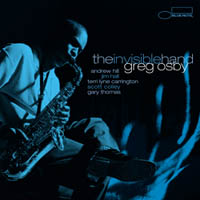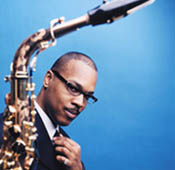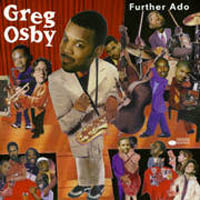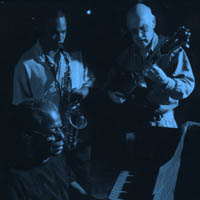EXCLUSIVE
INTERVIEW
WITH GREG OSBY

Conducted
by Victor Bradley May, 2000
©2000
Victor Bradley, BR Ltd., www.philzone.com
and www.2012productions.com
All rights reserved.
This
interview may not be reprinted anywhere in any
form
-- online or offline -- without the express written consent of Philzone.com.
However, we certainly
encourage you to link here.
Musical iconoclast, saxophonist/composer/bandleader Greg Osby whose many recordings for Blue Note Records have garnered him rave critical acclaim, performed with Phil Lesh & Friends at the Tower Theater in Philadelphia on April 14 (setlist). Greg's keening alto sound was a wonderful addition to a spectacular night of music. His contributions during the first set were laid back, complimenting the lines of Phil's stellar musicians but never getting in the way. He punctuated with short, boxed bursts of melodic invention bouncing ideas and rhythmic twists into the fold of the band's ambitious group improvisation on "Dark Star". After the initial pastoral development, drummer John Molo briefly turned a horn riff into a swinging bop rhythm before the entwined lines of the guitars and bass keyed back into the familiar motif. "Mountains of the Moon" followed with Osby adding delicate color to the spaces within the melody.
Where his contributions to set one were thoughtful in their restraint, the saxist's approach to the material in set two was more pronounced. Having felt his way into the fabric of Phil's musical tapestry in set one, Osby continued to give us a lesson in an artist's ability to listen to his surroundings and to adapt on the fly. From the exploratory call-and-response of the edgy, bluesy twists in the "New Speedway Boogie" (RealAudio: listen / download) jam to the lilting fills that spiral around an islandy "Friend of the Devil", Osby fit in well with Phil's "group improvisation" approach where no one soloist is out front to the detriment of the others. Osby laid back on the intricate changes of "Crazy Fingers" laying the occasional, long breathy tone as a bed for the changes above it. After leaving the stage for the band's new arrangement of "Terrapin Station" he returned to close the set with a pumped up version of Wilson Pickett's "In The Midnight Hour" (RealAudio: listen / download) which Greg had undoubtedly played during his formative years in St. Louis.
 The
39-year-old Osby has recorded 11 albums for Blue Note Records as a
leader and was recently joined by jazz legends Andrew Hill and Jim
Hall on Osby's latest release The Invisible Hand.
The
39-year-old Osby has recorded 11 albums for Blue Note Records as a
leader and was recently joined by jazz legends Andrew Hill and Jim
Hall on Osby's latest release The Invisible Hand.
One of the founders of the innovative of the M-BASE jazz style in the early 80s which fused hip-hop and funk elements to intense, forward thinking jazz improvisation, Osby has appeared alongside a long list of jazz' finest improvisers from McCoy Tyner, Joe Lovano, to Jack DeJohnette, Joanne Brackeen, Tom Harrell and many others. Greg toured
nationally last year, leading the New Directions band – a stellar line-up of young Blue Note artists whose self-titled debut Blue Note CD hit stores in January.
The 2000 Jazziz Readers' Poll has just announced the winners for this year which included: Greg Osby – #1 Alto Saxophonist, Greg Osby's band – #2 Working Jazz Group and Greg Osby – #3 Jazz Musician of the Year.
Victor Bradley spoke to Greg for Philzone.com in early May while Osby was in Los Angeles on the first leg of an extensive national tour (see http://www.gregosby.com for tour dates). He spoke below about his initial exposure to the "Phil Zone" in addition to speaking candidly about his views on tape trading, the jazz industry and the creative process.
Here's how it went...
Victor Bradley: First of all, glad to have you on the bus. Tell us a bit about how you wound up on-stage with Phil & Friends.
Greg Osby: It was brought to my attention that, in a Rolling Stone magazine article, Phil Lesh included one of my CD's as one of his top 5 favorites. Aside from being flattered by this information, my curiosity was ignited and a meeting with Phil was arranged during a stop on his tour. He requested that I bring my horn to the soundcheck (which was longer and more musical than many actual gigs) and I wound up performing on more than half of the total performance.
VB: Were you familiar with any of the Dead's music before all this?
GO: My mother used to listen to their recordings in the 70's so I was a bit aware of the sound of the work. Admittedly, I wasn't deeply familiar with much of it.
VB: What common ground, philosophically or structurally, do you feel your music and Phil's share that makes it seem to make sense for you guys to collaborate? Or are the differences what makes it an interesting mix?
GO: There are many similarities to the methods that Phil and I use to design the environments for our respective groups. The most significant one is the development of extended segues and transitions between compositions. We also share a penchant for liberal amounts of group improvisation. I also noticed that Phil implements a rather stylized cueing system that signals various tempo changes, shifts of the tonal center, modification of the implied themes, and subtle variations of the groove. I have many similar non-verbal/visual/musical cueing methods that I've worked out with my groups as well. I use them in an effort to keep the music flowing freely for the duration of the performances.
VB: When you met Phil did he comment on what it is that drew him to your music?
GO: Phil told me that he wasn't able to discern which elements of my music were improvised or were actual components of the written compositions. I found this to be entirely flattering and have always maintained that many of the most memorable compositions sound like improvisations.
VB: When you walked out on-stage at the Tower Theater it must have been like stepping into mid-air, not knowing what to expect, not only from the band but from the crowd out front. Give us a feel for what was going through your mind as you first hit the stage.
 GO:
Frankly, I had no reservations at all about going out to play with
Phil's group. From a musical perspective, I'm rather fearless when
it comes to unfamiliar situations and I not only look forward to them,
but choose to maintain an air of musical uncertainty in my own groups.
With regard to the audience, I have faced hostility before as well,
but in this instance, I felt welcomed and was immediately comforted
by ...(photo
© Jimmy Katz)
GO:
Frankly, I had no reservations at all about going out to play with
Phil's group. From a musical perspective, I'm rather fearless when
it comes to unfamiliar situations and I not only look forward to them,
but choose to maintain an air of musical uncertainty in my own groups.
With regard to the audience, I have faced hostility before as well,
but in this instance, I felt welcomed and was immediately comforted
by ...(photo
© Jimmy Katz)
the ravenous and warm applause. That, in and of itself, will always
elevate an artist's level of performance.
VB: Could you see the audience? A bit different looking than your average jazz crowd, eh?
GO: The audience did not fit my preconceptions visually. Most of the folks in attendance looked quite "normal". Actually, many appeared to be the children of the original Deadheads. Quite young, in fact. There were, however, many who looked as if they've never missed any performances at all. Whenever the band started a familiar melody or song, the crowd wildly acknowledged their recognition. It was loyalty at it's finest. It was the first time that I'd ever witnessed that level of mass support.
VB: We heard you had a good time working your way back to your car after the show.
GO: I was literally mobbed by dozens of attendees who let me know that they thought my presence and musical contributions that evening were the "coolest thing that they'd ever heard". I was also told several times that I "f**kin' rocked". Another first!
VB: As a jazz musician you must be used to challenging musical situations. As a guest onstage with someone what is your approach, and how does standing in front of a rock band differ from the jazz bandstand?
 GO:
For me, the focus when sitting in is to make what I do complimentary
to the situation and not to bring too much attention to myself. As
an improviser, the type of band or music that is played is not a deterrent.
In fact, I welcome any chance to play with musicians from other disciplines
- It keeps one's adaptive skills honed.
GO:
For me, the focus when sitting in is to make what I do complimentary
to the situation and not to bring too much attention to myself. As
an improviser, the type of band or music that is played is not a deterrent.
In fact, I welcome any chance to play with musicians from other disciplines
- It keeps one's adaptive skills honed.
VB: What do you listen for when approaching a new musical situation?
GO: Well hopefully, that the musicians can play! Being able to hear and make adjustments on the spot are other bonuses. It's surprising to find how many players only know what they know and aren't even remotely interested in growth or further development of their craft. This was never a concern with Phil's band as they effortlessly followed me wherever I wanted to go musically that night.
VB: There seems to be somewhat of a tradition of jazz saxophonists playing with the Dead and their family bands. Ornette Coleman, David Murray, Branford. Why not trumpet players? What is it about the saxophone that fits so well with this style of playing?
GO: It's not the instrument at all. The saxophone, like all other instruments, is merely a tool. It appears that some of the better trumpeters on the scene have interests other than expanding their knowledge base by collaborating with musicians outside of the Jazz tradition. Personally, I make it a point to play with as many players from other disciplines as possible.
VB: Branford Marsalis' experience was somewhat similar to yours...he was invited, by Phil, I believe to check out the Dead in the early 90s and wound up sitting in with them a few times and subsequently with Bob Weir's band, with Jerry and recently w/ Phil & Friends about a week after you did. You went to school with Branford?
GO: Yes, we were schoolmates at the Berklee school in Boston around 1980, '81. He was exclusively an alto saxophonist at that time.
VB: The members of this particular version of Phil's Friends are closet jazzheads. You started out in R&B groups in St. Louis? What kind of stuff were you playing?
GO: When I was a teenager in St. Louis I performed in a host of cover bands. We played the popular dance and soul hits. At that time I played primarily by ear.
VB: When did you first encounter jazz music and what attracted you to it?
GO: I got my first introduction to Jazz as a player during high school but I had absolutely no idea what was going on or what was required in order for me to participate. I was, even at that point, aware that a greater deal of knowledge and proficiency on my instrument was required for me to participate. I had to learn theory and harmony as well as bone up on my reading skills and playing technique. Jazz is far too complex to play by ear. Complex doesn't necessarily mean better, I must add.
VB: How would you describe the structural development of your compositions over the years?
GO: My compositions generally mirror the resources that I am studying at the time that they are written. Many of which are not always musically based.
VB: Do you write with particular players in mind?
GO: Sometimes, but rarely. I'm usually more concerned with getting the ideas or group of concepts across. Also, I try not to become "married" to any players or their styles because it has been difficult for me to keep musicians in my groups for very long. Some of the young cats in my groups stay on board for a while and usually get "stolen" by other bandleaders after I've done the difficult task of nurturing and cultivating them. They come in my band raw and unrefined and leave with finely developed skills - most of the time.
 VB:
You've recorded prolifically for Blue Note Records among other labels
and have quite a few unrecorded compositions in your book. What are
your feelings about the "tape trading" scene promoted by the Dead?
Recently many bands such as Medeski, Martin & Wood, Charlie Hunter,
rock bands like Metallica, Black Crowes, Blues Traveler, Allman Brothers,
Phish, most of the "jamband" scene, thrive on this word-of-mouth networking
as "free publicity" and have allowed and encouraged taping as part
of their lure to draw new people into the fold. You don't see condoned
taping as much in jazz circles, perhaps because of a early history
of artists being ripped off by labels and being a bit more paranoid
about protecting their "product." In fact I was chastised one night
by the late great drummer Tony Williams for even bringing up the subject!
What's your take?
VB:
You've recorded prolifically for Blue Note Records among other labels
and have quite a few unrecorded compositions in your book. What are
your feelings about the "tape trading" scene promoted by the Dead?
Recently many bands such as Medeski, Martin & Wood, Charlie Hunter,
rock bands like Metallica, Black Crowes, Blues Traveler, Allman Brothers,
Phish, most of the "jamband" scene, thrive on this word-of-mouth networking
as "free publicity" and have allowed and encouraged taping as part
of their lure to draw new people into the fold. You don't see condoned
taping as much in jazz circles, perhaps because of a early history
of artists being ripped off by labels and being a bit more paranoid
about protecting their "product." In fact I was chastised one night
by the late great drummer Tony Williams for even bringing up the subject!
What's your take?
GO: I am totally in favor of the trading of tapes. I fully endorse the practice. In fact, it very well could be the saving grace for the future of Jazz as we know it. There is no better and cost effective method for the promotion of Jazz. There is no budget, no manpower, no interest at all on the part of the Jazz labels to properly promote the music on a grassroots level so if anyone wants to record my shows, by all means - Do so! But please don't sell the tapes. Copy them and give them out.
VB: There are logistical considerations in the traditional jazz venues – what with the small nature of the clubs, sight lines not being obstructed etc. Tapers tend to take up a bit more room in this day and age with mic stands and equipment... though last year you convinced your label to release "Banned In New York" an album that for all intents and purposes was a "bootleg" style recording. Tell us about that CD – did the label think you were nuts?
GO: Quite the contrary. They were more than game to the idea as it cost practically nothing to produce. (It was recorded with a minidisc player placed on a table in front of the bandstand with one microphone) It captured the true essence of what a "live" recording should sound like and was one of my more successful releases. My music sounds much better live since the cats tend to freeze up in the studio (for fear of making mistakes) which, in turn, sometimes can make the music sound a bit too cautious or tentative.
VB: What was the critical and fan reaction to that record?
GO: For many who have never cared for or have never took the time to give my work proper consideration, they finally "got it". It was easier for many to put my performance concept into perspective on that recording as most of the material they were probably familiar with (Jazz standards). There is no substitute for a creative band captured live.
VB: Are you considering other releases of that nature?
GO: I'm always considering it, but I'm not the record company. They control the amount of releases. I have tons of material that is more than worthy of release and I would love to share it. Sometimes it can be quite frustrating and it makes me long for the good old days when artists would record whenever they were first inspired as opposed to the "one recording per year" contract requirements of today. Record companies are a business first and foremost - so I know why this is the way things are done.
VB: I hear that there is a guy from the Bronx who sets up at a lot of avant-garde shows – David Murray, WSQ etc. – who supplies the band with copies and plays the stuff on his radio show...
GO: I'd like for him to become a friend of mine. Please direct him to me if you know of his whereabouts.
VB: The 21st Century brings us face to face with a lot of new technological parameters in the music industry. Recently, there has been a lot of noise about artists issuing "collectors" oriented music on the Internet...rarities, outtakes etc. I read that Roger McGuinn from the Byrds recently released an MP3 of folk tunes that no label would bite on and sold about 1000 copies and made more profit than on his last couple of major label releases. There sure is a tradition in jazz of a segment of the fanbase who buy up alternate takes and sketchily recorded live dates (witness Mosaic's Dean Benedetti recordings of Charlie Parker and all the alternate takes floating around the innumerable reissues since the CD was introduced). How about MP3s and the downloading of "unofficial" music from an artist's perspective?
GO: If the music that is made available is not in direct violation of an artist's contractual obligations I see no harm in making alternate versions of unpublished works available to anyone that wants it. There is much more to gain - even though the labels don't quite see things that way.
VB: You've been a computer nut for a long time – do you use the computer as a compositional or rehearsal tool?
GO: I've always said that a computer never needs to go to the bathroom nor does it ever complain that it is hungry. I work out all my concepts on my computers at all hours of the night with nary a complaint. Again, like an instrument, it is merely a tool. Without a creative mind to drive it, it is of no use.
VB: Let's talk a bit about the craft of composing...In literature William Burroughs and Brion Gysin explored "cut-ups" as a methodology for adding a random element into the creative process. Artists such as David Bowie and David Byrne have utilized this to construct/deconstruct their lyrics – John Zorn has explored some of the same areas compositionally – filmmakers have also explored rhythmic editing as a way of creating jarring juxtapositions. Pianist Jason Moran, your close friend and musical collaborator has said that the two of you use different techniques to explore the creative process, as opposed to just waiting around for the muse to strike – any tricks, secrets, rituals or suggestions?
GO: I used to be a big fan of Hip-Hop so I have utilized a great deal of cut-and-paste techniques in my compositions. I borrow liberally from many different genres, styles and concepts - all in an effort to create a music that is expansive and a vivid portrayal of what interests me at the moment of inspiration. It would take far more room than this site has to offer (and better typing chops that I have to offer) for me to fully detail exactly what my methods are. I intend to publish my theories in a journal that I will make available to everyone in the near future.
VB: From R&B to post-bop to M-BASE to modern structurally unique composition to playing with a hippie rock-n-roll band – what is it that excites Greg Osby about his chosen profession?
 GO:
Meeting with and collaborating with other artists who share my enthusiasm
for discovery, spontaneity, and the creation of new music. It's also
extremely gratifying when people tell me that my music has made a
difference in their personal lives. That means a great deal as well.
GO:
Meeting with and collaborating with other artists who share my enthusiasm
for discovery, spontaneity, and the creation of new music. It's also
extremely gratifying when people tell me that my music has made a
difference in their personal lives. That means a great deal as well.
VB: Many Dead and jamband fans are very open-eared people. They seem ready to be challenged and surprised by the music that they seek out. For the novice jazz listener, what should they listen for in your music that will perhaps open their ears to a deeper understanding of what jazz is all about?
GO: All they have to be aware of is that a lot of Jazz sounds very much like Phil's band but uses different rhythms, and harmonies. Jazz refers to major figures in it's lineage as a matter of course quite often. This serves as a cohesive element and gives Jazz it's "sound" and helps to establish it's grounding.
VB: Finally, sum up the Phil Zone from a fresh, new recruit's perspective.
GO: I have to say that I am extremely impressed to have been introduced to a music that appeals to a core of listeners who appear to truly understand and support it unconditionally.
VB: We'd like to thank Greg and congratulate him on winning the 2000 Jazziz Readers' Poll Award as #1 Alto Saxist and on all of your recent successes. We want to encourage Phil phans to go out and catch you on the road with your great band, check out your CDs and we hope to see you on-stage with Phil again sometime soon...
Click
Here
For Available Albums From Blue Note Records
For More Albums Including Sound Samples Visit Tunes.com
Greg Osby's Tour Schedule (click here for latest)
|
|
|
|
|
| May 12-13 | Kansas City, MO | The Blue Room | Greg Osby Four |
| May 16 | Washington, DC | Blues Alley | Greg Osby Five |
| May 18 | Boston, MA | Museum
of Contemporary Art |
Greg Osby Five |
| May 19-20 | Atlanta, GA | Churchill Grounds | Greg Osby Four |
| May 26-27 | Philadelphia, PA | Zanzibar Blue | Greg Osby Five |
| June 2 | Hartford, CN | Cafe 880 | Greg Osby Five |
| June 3 | New Orleans, LA | Snug Harbor | Greg Osby Four |
| June 6 | New York, NY | Knitting Factory | Greg Osby Five |
| June 10 | New York, NY | Aaron Davis Hall | Jason Moran Group |
| June 16-17 | St. Louis, MO | Juneteenth Festival | Greg Osby Four |
| June 18 | Half Moon Bay, CA | Bach Dynamite | Greg Osby Four |
| June 23-24 | Detroit, MI | Serengetti Ballroom | Greg Osby Four |
| July 4 | Skidmore, NY | Skidmore College | Jason Moran Group |
| July 6 | Montreal, Quebec | Montreal Jazz Festival | Jim Hall Group |
| August 8-13 | New York, NY | Village Vanguard | Blue
Note New Directions |
| August 26 | Saalfelden, Austria | Saalfelden Jazz Festival | Greg Osby Five - featuring Oliver Lake & Bob Stewart |
| Sept 5-10 | New York, NY | Iridium | Lovano/Osby Group |
| Sept 16 | Monterey, CA | Monterey Jazz Festival | Tom Harrell |
| Sept 20-30 | Europe Tour | TBA | New Jazz Trio |
| Oct 20 | Houston, TX | Houston Jazz Festival | Jason Moran Group |
| Nov 15-Dec 15 | Europe Tour | TBA | Greg Osby Four |
From
Rolling Stone issue #832 - January 20, 2000
"Artist's
High Fives" - PHIL LESH
Varese:
The Complete Works/Chailly, ASKO Ensemble, et al., Edgard Varese
Ives:
Symphonies Nos. 2 and 4/Ormandy, Serebrier, et al., Charles Ives
Zero,
Greg Osby
Asyla,
These Premises are Alarmed, etc./Rattle, etc., Thomas Ades
The
Complete Bitches Brew Sessions, Miles Davis
Also see JAZZe Phil/Osby Coverage Here
.